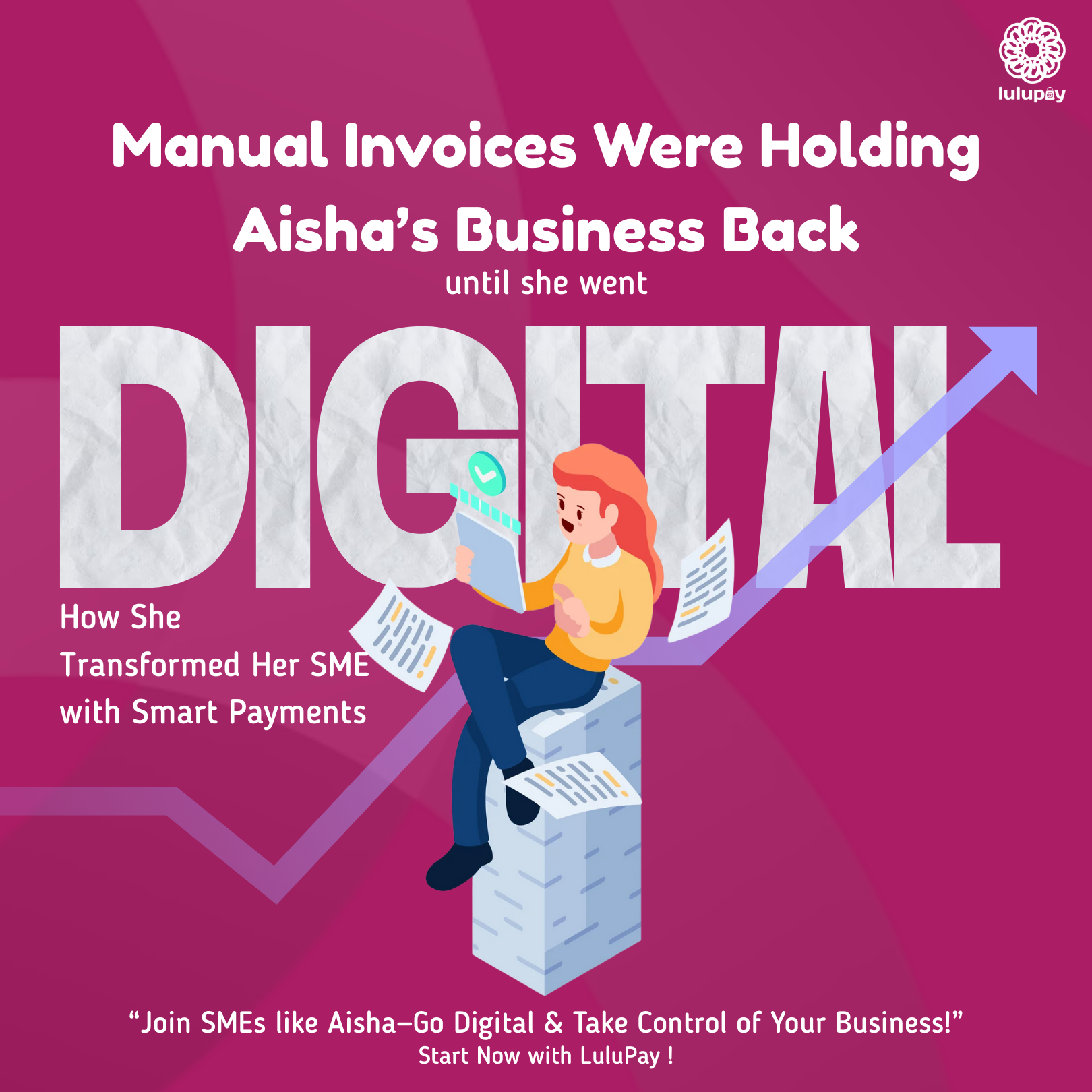Running a small business is tough.
Just ask Aisha, the founder of an artisanal skincare brand that started as a passion project.
At first, she handled everything manually—sending invoices, tracking payments, managing stock—all while trying to grow her brand. But as orders increased, so did the chaos.
The biggest problem? Payments.
Late invoices & follow-ups drained her time.
Multi-currency transactions from international buyers were eating into profits.
Manual tracking meant she was buried in spreadsheets instead of scaling her brand. Aisha knew she needed a smarter way to handle payments without hiring a full finance team.
This is exactly the challenge many SMEs face in 2025. The good news? Fintech solutions like LuluPay are making it easier than ever to simplify transactions, reduce costs, and scale globally.
Here are three fintech trends that helped Aisha—and how they can help your business.

1️. Automated Payments & Invoicing: Get Paid Faster
What’s Changing?
Small businesses are ditching outdated, manual invoicing methods and moving toward smarter, automated systems. Why? Chasing late payments, manually updating spreadsheets, and handling bank transfers one by one aren’t just time-consuming—they slow down cash flow and distract business owners from growth.
With the rise of digital payment tools, businesses can now send professional invoices instantly, set up automated reminders, and track transactions in real-time—all from one platform.
How Aisha Used It
As the orders for Aisha’s handmade goods grew, so did the paperwork. She was spending hours every week following up on late payments and double-checking transfers. That all changed when she switched to LuluPay’s smart invoicing system.
Here’s how it helped:
- Instant Digital Invoices: Customers received clear, branded invoices immediately after placing their orders.
- Real-Time Payment Tracking: Aisha could see who paid and when removing the need to manually follow up.
- Flexible Payment Options: Her customers could choose from multiple payment methods—credit card, bank transfer, or even e-wallets—making it easier and faster for them to complete the transaction.
Thanks to automation, Aisha reduced her admin workload by over 70%, got paid faster, and had more time to focus on new product launches and brand partnerships.
Thinking about switching to automated invoicing? Ask yourself:
“Do I spend too much time chasing payments?”
“Am I missing out on cash flow because of delays?”
“Could automation help me grow faster?”
If the answer is yes, it might be time to make the move—just like Aisha did.

2️. Multi-Currency & Borderless Payments: Sell Worldwide with Ease
What’s Changing?
In 2025, small businesses are no longer bound by borders. Thanks to social media and online marketplaces, it’s easier than ever to attract global customers. But here’s the catch—traditional payment systems haven’t caught up. Cross-border transactions often mean hidden fees, slow processing times, and headaches with currency conversion.
This creates friction for both the business owner and the customer. For small brands trying to scale internationally, that friction can become a real barrier to growth.
How Aisha Used It
Aisha’s products began gaining traction outside of her home country. But every international sale came with added stress—unexpected transaction charges, currency mismatch issues, and long delays in receiving payments.
That changed when she switched to LuluPay’s multi-currency solution:
- Real-Time Currency Conversion: Customers could see prices in their local currency, with no surprise fees at checkout.
- Faster Cross-Border Transactions: Instead of waiting days for international payments, Aisha received funds quickly and reliably.
- Seamless Global Checkout: With support for multiple regions and payment methods, she turned hesitant browsers into confident buyers.
Within just a few weeks, her global sales increased by 40%. And instead of worrying about payment friction, she could focus on reaching new markets and delighting customers around the world.
Wondering if it’s time to go global?
If so, adding a borderless payment solution—like Aisha did—could be the game-changer your business needs.

3️. Integrated Financial Solutions: One Platform for Everything
What’s Changing?
Running a business used to mean juggling different platforms—one for payments, another for inventory, something else for accounting. This patchwork system often caused confusion, errors, and wasted time.
In 2025, more small businesses are switching to all-in-one platforms that bring everything under one roof. From accepting payments to tracking stock and monitoring cash flow, business owners want one connected system that just works.
How Aisha Used It:
Before switching, Aisha constantly had to check three different tools to manage orders, update inventory, and track payments. It was overwhelming and made it hard to spot issues before they became serious.
With LuluPay, she linked her payment gateway directly to her online store and inventory system. Every time a customer placed an order:
- Payments were processed instantly
- Inventory was automatically updated
- Sales and financial reports were logged in real time
The entire process became seamless—not just for Aisha, but for her customers too. Shoppers could browse, order, and pay without a hitch, and they noticed the difference.

